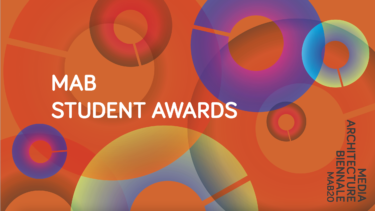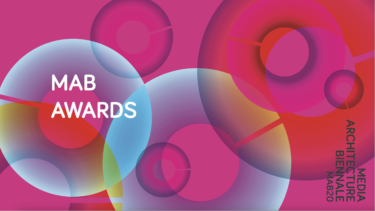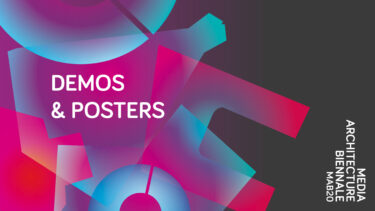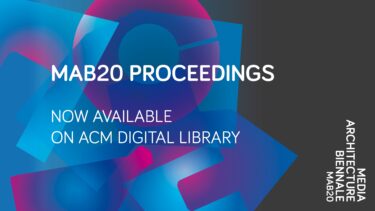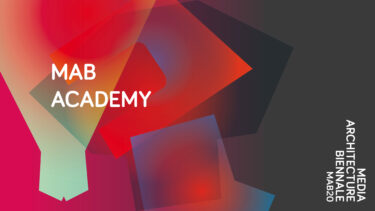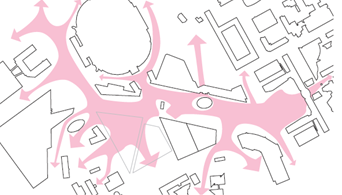MEDIA ARCHITECTURE AND ITS FUTURES IMPLIED
Editorial for Volume Magazine by Martijn de Waal, Frank Suurenbroek, Nanna Verhoeff, Michiel de Lange
MAB20 Executive Committee
The Media Architecture Biennale is the world’s premier event on media architecture, urban interaction design, digital placemaking, urban media art and urban informatics.
As we design and adapt new technologies, in turn these technologies shape our cities. What future scenarios are implied in today’s urban technologies? And how can we shape our technologies to respond to their surroundings, contributing to cities that are both socially and ecologically sustainable?
Originally, media architecture was most concerned with the integration of displays and interactive installations into architectural structures, such as media facades and urban screens. Over the years, the discipline has grown much broader, as new technologies such as digital platforms and smart city technologies have increasingly made their way into the experience, management and design of cities.
None of these technologies brought into the city are neutral enablers, mere decorative structures or just simple market places connecting demand and supply in fields as diverse as energy and transport to commerce and leisure. They are built upon numerous spoken and unspoken assumptions about urban life, each with their own implications for both social relations as well as their effect on the natural ecosystem. It is time therefore for the discipline of media architecture to address the implied futures of new technologies.
MAB20 calls for media architectures that move beyond the mere spectacular; as well as beyond the design of individualized services comforting human customers. MAB20 calls for media architectures and urban interaction that dare to take on a more-than-human approach: aiming at the well-being of the natural ecosystem as a whole; For urban media art and design that bring implicit and explicit bias within technology and culture to light, and provide the means for ongoing discussion, debate, and societal change; For digital platforms that strengthen citizen’s digital rights in democratic societies.
Themes & Issues
When discussing the futures implied in new urban technologies, criticisms abound. They often depict scenarios containing the three C’s of Control (states and companies capturing and nudging our behaviours), Capsularisation (social fragmentation), and Commodification (narrowing the city to the development of individualised infrastructural services catered to – usually the highest paying – customers, rather than seeing cities as communities of citizens).
In response, various actors have expressed the need to design urban technologies from a values-based perspective. Cities such as Amsterdam, Barcelona and New York have called to embrace citizen’s digital rights in the application of technologies to design (Cities for Digital Rights 2019). Designers, researchers and policymakers have argued for the explicit inclusion of public values in the design of digital infrastructures (Van Dijck, Poell & De Waal 2018; De Lange & de Waal 2013). And increasingly, an awareness has been raised about the necessity to include the well-being of the natural ecosystem at large in the design of media architecture (Foth & Caldwell 2018; Clarke, Heitlinger, Light, Forlano, Foth & DiSalvo 2019).
At MAB20 we want to open up this debate by bringing out desirable futures that media architects can contribute to. How can media architecture trigger social sustainability and citizen’s digital rights, collective action and new dynamics in public spaces? How can it help to balance between consumption and sustainability, and reconcile the broader interests of humans with those of non-humans and the broader natural ecologies in our cities? And how can it catalyse change towards sustainable mobility and consumption patterns, bringing out more circular economies?
In exploring these questions, the following themes are of specific interest:
- The Aesthetics and Poetics of Responsive Urban Spaces
Inclusive democratic societies need media architectures that contribute to vibrant public spaces. As such, media architecture should contribute to a sense of place, deepening citizens’ understanding of and attachments to locales and habitats. It activates public spaces as an ‘urban theatre’ where citizens can take notice of each other, and (playfully) interact with each other. It makes places more legible and also imaginative, in ways that stimulate exploration, reflection and criticality. It should also make the (re)design of urban spaces more inclusive, bringing in perspectives from various stakeholders. - Citizens’ digital rights in the era of platform ecologies
A nascent platform society in which economic, social and cultural urban relations are mediated through digital platforms needs an architecture that is open and inclusive as well as transparent and accountable, underwriting citizens’ digital rights. We need to explore alternatives for ‘extractive’ platform economies, for example, by further investigating privacy and autonomy-by-design, commons-based collaborations and platform-cooperatives. We need a media architecture that articulates public values and allows citizens to govern to digital platforms, rather than be governed by them. - Playful & Artistic Civic Engagement
Smart Cities need media architectures that not just increase efficiency, but instead need technologies that create meaningful experiences. As an alternative, ‘playful cities’ promote a people-centric view of the smart city in which citizens themselves learn, negotiate and create innovations through play and games. Shaping our urban futures is a challenge of the imagination rather than a technological challenge. To become serious about our planetary urban future, we need imaginative gameful tools and playful interventions. - Restorative Cities
Socially and ecologically sustainable cities make use of the affordances of media architectures to restore socially, ecologically and physiologically on multiple levels, from the individual human, groups of people to the city as an entity of systems. We need media architecture to create ‘restorative pockets’, on the levels of the building (like immersive rooms to create help elderly relive their past); the street (creating active public space, collective ownership, local communities); the city (shaping socially and ecologically resilient entities) ; and the level of the globe (preventing a race to the bottom competition, fostering transnational learning – and answers to the downside of new technologies). - More-Than-Human Cities
Sustainable cities need media architectures to embrace the well-being of the natural ecosystem as a whole. As our planet is rapidly urbanising, ‘nature’ has become encapsulated in urban life, to the instrumental logic of modern technology. This places severe strains on animals, plants and critters, and – ultimately – also our own well-being and health. We need media architectures that enable us to “live together” with other beings in ways that respect them, and allows for their difference and unicity to exist.



